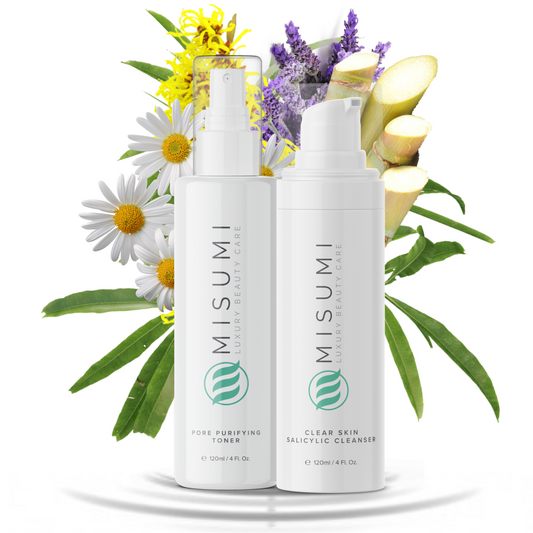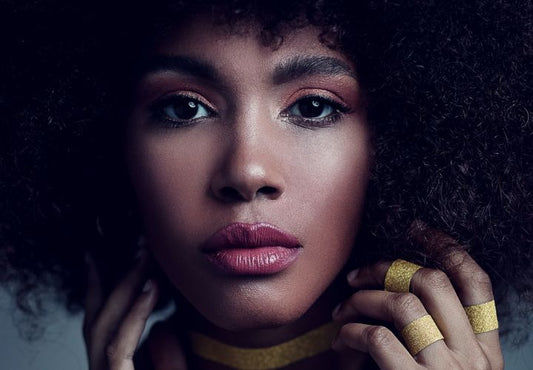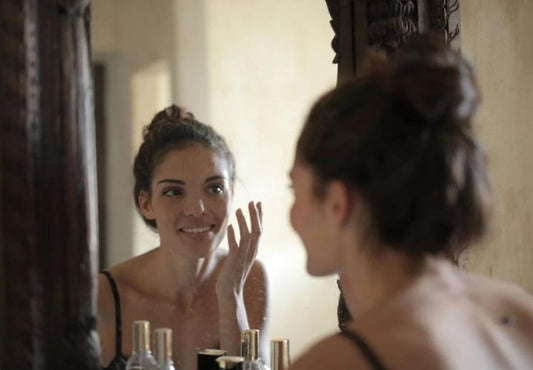For better or worse, all acne is not created equal. Some people have milder forms, while others have to deal with their severe acne problem for months or even years. But today we’re looking at solving a very specific acne problem - how to get rid of chin acne.
Chin acne is a fairly ordinary form of acne, but one that affects perhaps the largest number of people - and it can leave scars. For those of you who’ve hit the jackpot in less favorable ways, feel free to check out our articles on Getting Rid of Cystic Chin Acne and Cystic Acne on the Neck: Causes and Treatment.
In the meantime, we’ll take a look at chin acne: what is it, how you can get rid of it and how you make the most effective home remedies that treat chin acne.

So What Is Chin Acne?
Well, of course, it’s acne on the chin. But, by acne here, we mean the usual, reddish pimples - not the huge, swollen, wobbly cystic acne. While it’s fairly easy to differentiate between cystic acne and “normal” acne, things get a bit hairy when trying to figure out if a pimple is indeed a pimple.
Before you begin any type of chin acne treatment, you need to make sure that those things on your chin are indeed acne. Why? Well, because they can be a few other things too, and in that case they won’t respond well to the treatments we will consider here.
For example, chin acne is not rosacea. In your defense, rosacea can look pretty similar. It looks like a red rash made up of hundreds of tiny red pimples and it usually covers a wider area on your face. That is, perhaps, its most tell-tale sign: while acne isn’t usually spread out evenly across an area, rosacea often is. If you have mid-sized red pimples spread apart from each other, interspersed with areas of healthy skin - it’s acne, not rosacea.
Another phenomenon that gets confused with acne way too often is the infamous ingrown hair. While fairly common among men because of shaving, ingrown hairs happen to women too - but, understandably, in different parts of the body. But what is an ingrown hair? Well, due to a wrong move with the razor, one or more hairs can sometimes turn back and get stuck in a skin pore. Which doesn’t prevent them from growing, inside the pore… Which makes for a nasty pimple. While similar in appearance, it’s not acne, and it requires different treatments.

How To Get Rid Of Chin Acne
Try not to experience choice paralysis, because there are too many possible treatments for chin acne. However, to make it easier on you we tried to select some of the best ones here. The treatments come in roughly three categories: topical spot treatments, home remedies, and stronger, medical treatments.
Topical Treatments For Chin Acne
With the exception of some home remedies that are also applied topically, you can find most of these products sold over-the-counter. These acne treatments usually consist of gels, lotions, creams, and other kinds of skin care solutions. However, when considering a topical product for treating chin acne, make sure that it has at least one (or ideally more) of the following ingredients:
- Benzoyl peroxide: An ingredient that is very rich in oxygen, it basically gasses the harmful bacteria causing the acne inflammation and lessens redness and swelling.
- Salicylic acid: Acts as a drying agent of the skin, which makes the surface layers easier to peel off. This helps your skin in removing dead skin cells, bacteria corpses, and random dirt. Our Misumi Clear Skin Salicylic Cleanser is one of the best in its class, so feel free to check it out.
- Sulfur: Sure, it stinks like rotten eggs, but it removes all excess oil, blows up clogged pores and dissolves the sebum on which the bacteria feed.
Additionally, you can try out products containing aloe vera. It’s one of the most powerful treatments for skin care, helping skin heal and soothe much faster.

When you finally get your hands on a product containing these ingredients, follow the manual. Everyone’s skin is different, so be careful when applying these solutions and be on the lookout for irritation or allergic reactions. Before beginning treatment with a new and untested product or a substance, it's always wise to perform a patch test. If your skin reacts negatively to any product or treatment listed here, you should stop immediately, wash your face with mild water and consult your doctor or dermatologist.
Home Remedies For Chin Acne
Most of these are super simple, but home remedies being home remedies, their effectiveness will vary. Still, you’ll never know if you don’t try. So give these a shot and tell us how it went!
Ice Freezes Chin Acne
Be warned: you’ll need water and a functional fridge for this treatment. Take several ice cubes and wrap them in a clean cloth. Then, touch them gently on the chin acne and keep it there until you feel some numbness. Do this up to twice a day, and you should see a reduction in the redness and the swelling.

Chin Acne Hates Lemon
Squeeze some lemon juice in a bowl, or on your fingertips and dab some over the pimples. Of course, you should wash your hands first, duh. Let the lemon work its magic for like 15 minutes and wash it off. You can do this every day - lemon juice is an astringent, meaning it cleans your pores and has antibacterial properties.
Tea Tree Oil For Chin Acne
You’ll need another type of oil for this to work. Usually, coconut oil works well as a carrier, so take a teaspoon of coconut oil and add 2-3 drops of tea tree oil in it. Mix it well, then dab this concoction over the pimples on your chin. Then go to bed, let it work its magic, and wash your face in the morning. Tea tree oil has antibacterial properties, but it can also reduce inflammation. The coconut oil is there to soothe your skin too.

Toothpaste Burns Chin Acne
You probably know this, but let me remind you - be very careful when applying toothpaste on your skin. To beat chin acne though, paint a touch of toothpaste on each pimple and leave it overnight. Wash your face with cold water in the morning. Clean yourself of all that good, antibacterial baking soda and hydrogen peroxide toothpaste contains.
Steamed Chin Acne
The important ingredients in preparing this meal are water, a bowl, and a clean towel. Boil some water and pour it in a bowl, then place your face right over it. Cover yourself with the towel so as to maximize the steaming temperature. Tolerate this atmosphere of an alien planet for 5 to 15 minutes, and your chin acne won’t know what hit it. The hot steam opens up your pores and unclogs them, while the heat kills off the bacteria. Then, of course, wash your face to refresh yourself a bit. Welcome back to Earth.
Garlic For The Chin Acne Vampire
Take a couple of garlic cloves, slice them open (or crush them) and apply them over the chin acne. Hold the garlic entrails there for at least 15 minutes, and rinse it off. Garlic blood is poison to fungi and bacteria, and it also contains zinc and copper that nurture your skin.

Make Your Chin Acne Drink Some Apple Cider Vinegar
And, of course, in true mad scientist fashion, see what happens! To perform this experiment, add 1 teaspoon of apple cider vinegar to 3 teaspoons of water. Then, target the pimples in the chin area with this concoction, until it dries out. You can either wash your face or apply some moisturizer because apple cider vinegar dries up pimples and sweeps off dead skin cells.
Cinnamon Cake For Chin Acne
Take a teaspoon of cinnamon powder (yes, the spice) and add some water to it. The goal is to have a thick paste, which you will then apply to the chin acne and leave for 10 minutes. Then, wash your face and… Well, you will need to do this twice a week before you see any results. But cinnamon packs a 3-in-1 punch: it is antibacterial, anti-inflammatory, and antioxidant.
Medical Treatments For Chin Acne
If none of these over-the-counter acne products and home remedies work, you can always try, you know, conventional medicine. Head over to your doctor or dermatologist and they’ll probably prescribe you one of the following medicines.
Topical Antibiotics For Acne
Strong acne medications, like antibiotics such as tetracycline, clindamycin, erythromycin, and metronidazole are often prescribed by dermatologists in topical form. They can come in the shape of creams, gels or solutions, and they’re used in much the same fashion - by applying some on the affected spots. Make sure you follow the instructions and your doctor’s advice.

Oral Antibiotics For Acne
The same class of antibiotics can also be taken orally, in the form of pills or tablets. Trimethoprim, clotrimazole, tetracyclines, and erythromycin are the common oral antibiotics prescribed for chin acne.
Birth Control Pills For Hormonal Chin Acne
If you’re a woman, another alternative for treating chin acne are the ortho tri-cyclen, estrostep, and YAZ birth control pills. These will help regulate certain hormones (estrogen and progesterone), in case your case of chin acne is hormonal. Take special precautions when taking any sort of hormonal therapy, though, because the consequences can be long term.
Accutane, Or Isotretinoin For Chin Acne
When even doctors and dermatologists get fed up with acne, they pull out the big guns. Accutane, also known as isotretinoin is a form of Vitamin A that is taken orally and works on a very deep, cellular level. It’s usually reserved for treating cystic acne, it is forbidden to pregnant women, and therapy lasts for up to 6 months. For more on Accutane or Isotretinoin in treating acne, check out our article on using Accutane For Mild Acne: All You Need To Know.

Summing It Up
Well, in case you’re suffering from chin acne, you can’t complain - there are plenty of treatments available to you. Regardless of which ones you decide to try, always consult with your doctor or dermatologist, and good luck!
This information is meant to supplement, not replace advice from your doctor or healthcare provider and is not meant to cover all possible uses, precautions, interactions or adverse effects. This information may not fit your specific health circumstances, and its goal is to offer a general view of the subject. In case you are suffering from a severe case of acne, you should consult with a dermatologist or a certified medical professional.







